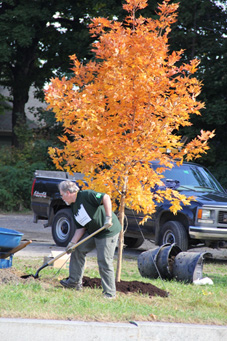Right Tree - Right Place

We all know the benefits of trees in our landscape – shade, beauty, wildlife habitat – to name just a few, but if you don’t choose the right species for your site, it won’t thrive or even survive.
First of all, know your Hardiness Zone. The U.S.D.A. has determined 11 zones throughout the U.S. that provide an annual range of temperatures for those areas. These are very helpful in determining which trees will survive where you live. Most of Maine is in zones 3-5. Find your zone here.
Second, know your property. It is best to observe your property for a full year before investing in and planting something as permanent as a tree. Where are the sunny spots? Is one corner very windy? Where does the sun hit in the winter versus in the summer? Many microclimates can exist in one small plot of land. A sun-drenched ell against your house can be many degrees warmer than a windy field.
You also want to consider moisture availability. A sandy dry corner near the road isn’t the perfect spot for a water-hungry willow. Trees need a substantial amount of water, especially as they get established. Will you be able to water the tree often and deep enough? A couple of days of lugging heavy watering cans for multiple trips can soon sabotage your good intentions.
Remember that trees also can provide cooling in the summer and solar warmth in the winter. A big, leafy maple can shield your house from the hot sun in the warmer months, yet can let the sun strike your house once the leaves have fallen when the temperatures drop. A row of evergreens can provide a windbreak from an open field – or a noise buffer from a busy highway.
Lastly, how big is your space? Remember that a mighty oak springs from a tiny acorn. Perhaps that oak shouldn’t live under power lines, or you will be faced with substantial and frequent pruning – possibly with having to remove it entirely. Consider the breadth of the mature tree as well as the height. And don’t forget the roots – they spread out at least as far as the edge of the canopy, if not farther. Don’t plant too close to your foundation or driveway. Both the tree and the “obstacle” will suffer.
Ok – so you know your property, you know your microclimates and you know where and where not to plant. So what will you plant? There are many resources available to you.
Your local nursery can be a great place to start. Most reputable places will stock only hardy trees suitable for your area. Be sure to look at the tags attached to the sapling. It will give you hardiness, moisture and sun needs as well as size and other helpful tips.
Be sure to steer clear of non-native invasive species. These plants often crowd out native species and can upset the delicate balance present in our ecosystems. A great resource to learn more about invasive species is the University of Maine Cooperative Extension.
You also should invest in a good tree guide. The Maine Forest Service has been publishing “Forest Trees of Maine” for more than 100 years. It is a wonderful resource and includes Maine’s native species as well as some common, introduced species. Visual characteristics as well as preferred environment are provided for each species, and there is a bit of history as well.
Don’t forget to look around your neighborhood. Species that thrive in your neighbor’s yard will most likely do well in yours. And if you ask your neighbor about their favorite tree, you’ll probably get a good story as well.
Once you have the perfect tree for the perfect spot, you need to know how to plant it and care for it. A little preparation before you plant a tree will provide you with many, many years of joy – it’s worth it.